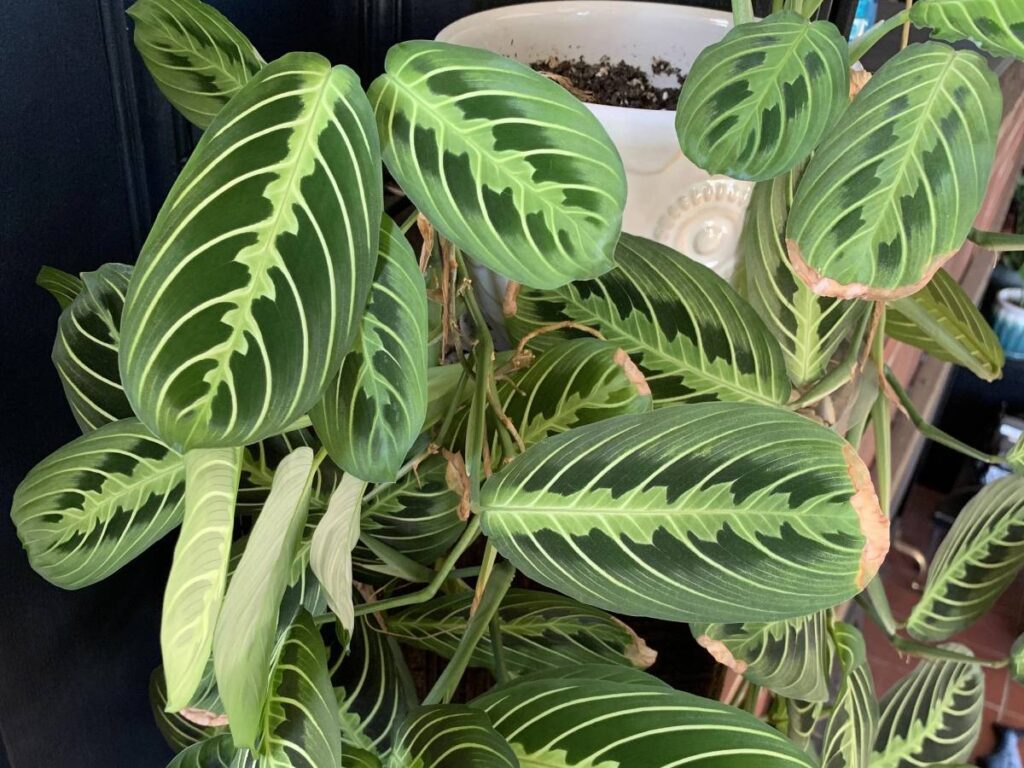Pruning is a necessary part of life; as they say, “less is more.” Pruning plants can be intimidating, but with the right knowledge and tools, it’s an easy task.
This article will provide all the information needed to successfully trim your prayer plant (Maranta leuconeura). It covers topics such as when to prune prayer plants, where and how to cut them back, and what things should be taken into consideration while doing so.
With this guide in hand, even a beginner gardener can tackle this project easily.
Here’s How To Prune Prayer Plant?
Start by cutting off any dead or brown leaves. Then, trim off any yellow or discolored foliage. To encourage fuller growth, cut off the top of the stem at an angle. For denser foliage, pinch off the tips of the stems. Finally, check for any insects and remove them.

Where Do You Cut On A Prayer Plant?
When it comes to pruning prayer plants, the most important thing is knowing where and how much of the plant to cut. This can be a tricky process, as each stem has several leaves that need to be considered before making any cuts.
To get started, inspect which stems are healthy and which ones are dead or damaged. Then, use sharp scissors or shears to make clean cuts just above the nodes—these are the areas right below each leaf’s base.
Doing this will encourage new growth from those nodes and promote bushier foliage for your prayer plant in the future. Make sure not to take off too much at once; only trim back what needs to be done in order to keep your plant looking neat and tidy.
The Benefits Of Pruning A Prayer Plant
Like the petals of a flower, pruning a prayer plant can help it blossom into its fullest potential. Taking the time to give your prayer plant some tender, loving care comes with many benefits that are sure to bring an abundance of joy and life back into your home. Here’s why you should consider giving this simple task a go:
- Firstly, trimming away any dead leaves or stems will leave behind a neat and tidy looking plant – one that’s aesthetically pleasing to look at.
- Secondly, by cutting off overgrown roots or shoots, you’ll be encouraging new growth which can give your prayer plant more healthful foliage and vibrant colors.
- Lastly, regular pruning encourages the production of blooms for those plants that have flowering varieties.
In short, there is much benefit in taking the time to prune your prayer plant, from improved appearance to healthier growth and even blossoming flowers! A little effort now could mean great rewards in the future, so why not get sniping today?
When Is The Best Time To Prune A Prayer Plant?
It is a beautiful sight—the lush, green prayer plant standing tall in its pot on the windowsill. But did you know that to keep it looking its best and ensure continued growth, occasional pruning is essential? When is the best time to give your beloved houseplant some TLC?
The answer lies in timing: just after the prayer plant has flowered or when new leaves appear. Prune gently with sharp scissors, snipping off any dead foliage at soil level as well as long stems that are drooping down from above—this will help encourage a fuller and more compact look for your thriving prayer plant. Allowing some of the older leaves to remain provides nourishment to the newer ones, so don’t overdo it!
Regularly trimming away excess greenery ensures optimum air circulation around the leaves and helps reduce potential fungal problems. Plus, by removing spent blooms, you can redirect energy into producing fresh flowers again next season. With just a little bit of effort each year – like regular watering, fertilizing, and grooming – you can enjoy an abundant display of exotic beauty indoors all year round.
How To Prepare The Prayer Plant For Pruning
Pruning a prayer plant can be daunting, but if you take the proper steps, it’s an easy process. Imagine yourself as a master gardener, trimming and grooming your precious foliage to perfection, and get ready for the task at hand!
First things first: gather all of your supplies. You’ll need sharp pruning shears or scissors, gardening gloves, and some type of cleaning solution like rubbing alcohol or peroxide. Once you have everything organized and within reach, prepare the prayer plant by carefully removing any dead leaves or stems. This will help ensure that your healthy growth remains unharmed during the pruning process. Additionally, dampen the soil around the base with water so that it won’t dry out while being trimmed.
Now comes the fun part—time to start snipping away! With gentle, precise movements, remove any wilted or yellowed parts of the plant in order to promote new growth by encouraging air circulation through its branches. Keep each cut clean and avoid tearing off sections, which may damage other areas of the foliage.
Afterward, wipe down both sides of each blade with one of your chosen cleaners before moving onto another section or piece of equipment. This is an important step in preventing disease from spreading throughout your garden space! When finished pruning, don’t forget to give your hard work a good drink; prayer plants are thirsty little critters after all!
The Proper Tools To Use For Pruning A Prayer Plant
Pruning a prayer plant is like giving it a haircut: the right tools can make all the difference.
When selecting pruning tools, choose those that have sharp blades and are designed for delicate plants such as the prayer plant. A pair of scissors or garden shears with narrow blades will work well, as they’ll give you greater control over how much foliage you remove.
Avoid using blunt-edged instruments; these could cause damage to the leaves and stems.
It’s also helpful to use gloves when handling your prayer plant during pruning; this will help protect both you and your plant from any potential harm.
Make sure to clip only healthy parts of the plant; discolored, wilted, or otherwise unhealthy foliage should be avoided in order to keep the prayer plant looking its best.
As you go about trimming away unwanted growths, always remember to snip at an angle above where new shoots are emerging so that light can reach them better after pruning.
Pruning Techniques For A Prayer Plant
Pruning a prayer plant can seem like an intimidating task; it’s almost as if the leaves are begging you not to do it! But with the right techniques, pruning your prayer plant doesn’t have to be scary. In fact, taking good care of your plant by properly pruning it will help keep its beautiful foliage lush and full. Here’s how to get started!
The most important thing to remember when pruning is that you should always trim away dead or damaged growth first. This helps ensure that only healthy parts of the plant are left behind while removing any potential sources of disease or pest infestation.
You’ll also want to make sure that all of your cuts are clean and sharp; dull blades can cause tearing in the stems, which leads to further damage down the road.
For more intricate shapes, such as crown-shaping or pinching off new buds, use a pair of scissors or garden shears for precision cutting and accuracy.
Finally, don’t forget about fertilizing after pruning; this helps promote new growth and keeps your prayer plant looking its best!
TIP: When pruning a prayer plant, take care not to cut away too much foliage in one go; instead, focus on small snips here and there around the edge of each leaf cluster, leaving plenty behind for healthy regrowth.
So there you have it: armed with knowledge on proper tools and techniques, you now know everything you need to start giving your prayer plant some much needed TLC through careful pruning. Take time to assess each branch before snipping away so that you only remove what needs to go; plus, using these steps means less stress for you too!
How To Care For A Prayer Plant After Pruning
Now let’s talk about how to care for your plant post-pruning. To keep it looking its best (and encourage robust growth), here are five things you should do:
- Water regularly so that soil remains evenly moist but never soggy
- Feed with liquid fertilizer every few weeks during spring and summer months
- Place in bright indirect light for optimal results
- Check periodically for pests such as aphids or mealybugs
- Regularly turn pot around to ensure even exposure on all sides
With these simple tips in mind, caring for your prayer plant should become second nature! Allowing adequate time between prunings also gives them space to grow naturally without interference.
Common Mistakes To Avoid When Pruning A Prayer Plant
Pruning a prayer plant can be tricky, but with the right know-how and some careful attention, it’s an easy job to get done. The main thing is to avoid making any common mistakes that could damage your plant. Here are a few tips to help you out.
First of all, don’t prune too much at once. Pruning should only remove dead or diseased leaves, not healthy ones. If you cut off too many stems or leaves in one go, it’ll take your prayer plant longer to recover and might even kill it. Make sure you always leave enough foliage on the stem so the plant will remain strong and bushy.
Also, make sure you use clean tools when pruning—never use scissors or shears that were used for other plants as they may contain bacteria or fungi that could harm your prayer plant.
And finally, try not to move or disturb the soil around the roots during pruning; this can cause shock and weaken its growth potential over time.
With these basics in mind, you’re well on your way to successfully pruning your prayer plant! Just remember: proceed slowly and carefully, taking care not to cut away too much foliage at once—then enjoy watching your beautiful houseplant flourish!
Signs That A Prayer Plant Needs Pruning
Pruning a prayer plant is an essential part of its care. If it’s done incorrectly, the plant can suffer from unhealthy growth and damage to the root system. A good way to know when pruning is necessary is by looking for signs that your prayer plant needs attention.
Take Mike’s experience as an example: he noticed yellow spots on his prayer plant leaves, which meant it was time to trim them back. He also observed that some stems were much taller than others, so he knew he had to cut those down too.
When you’re looking out for signs that your prayer plant needs pruning, start with the leaves – if they look wilted or discoloured, then it’s likely time to get your scissors ready.
Also make sure all the stems are even in length; otherwise go ahead and snip off any excess foliage. You may also spot overgrowth where more shoots have come up around the base of the main stem – this isn’t ideal and should be removed carefully.
Lastly, keep an eye out for pests like mealybugs which can cause harm to your plant if not caught early enough.
By paying close attention to these key indicators, you’ll be able to tell quickly whether or not your prayer plant requires pruning – and act accordingly!
Alternatives To Pruning A Prayer Plant
The lush, green leaves of the prayer plant swaying in a gentle breeze are an inviting sight that captivates and refreshes. But how can we keep it looking its best without having to resort to pruning?
Thankfully, there are plenty of other ways for us to care for our prayer plants. Topping off their water levels is one way; this prevents them from drying out too quickly, but be careful not to over-water as that may cause root rot. In addition, providing adequate light ensures optimum growth without any stunting. It’s important to remember, though, that direct sunlight should be avoided at all costs lest you risk burning the leaves. A good rule of thumb here is that if your room doesn’t have enough natural lighting, try using fluorescent lamps instead.
Furthermore, fertilizer applications should be done on a regular basis (every three months or so), as feeding helps promote vigorous growth, which leads to more vibrant foliage coloration.
And finally, temperature control plays an essential role in keeping your prayer plant healthy—make sure the space isn’t too cold or else the roots will suffer!
With these tips in mind, you’re bound to have a beautiful and thriving houseplant that’ll last for years.
Troubleshooting Common Problems With Pruned Prayer Plants
Pruning a prayer plant might seem like an easy task at first, but if done incorrectly, it can cause some serious problems down the line. From leaf discoloration to stunted growth, even experienced gardeners have been known to make mistakes while pruning their precious plants!
But fear not—with these troubleshooting tips, you’ll be able to keep your prayer plant looking as perfect as when you bought it.
Firstly, and most importantly, take care when removing any unhealthy leaves or stems from your prayer plant. If you’re too aggressive in your trimming, then you may end up damaging healthy sections of the plant by accident! Instead, use small scissors and cut just above where the leaf meets the stem; this should help avoid any unnecessary damage.
Next, try to remove no more than one-third of the total foliage on each branch that’s being pruned. This will ensure that there is still enough foliage left for photosynthesis and water absorption without stressing out the plant too much. Additionally, don’t forget to give your newly-pruned branches plenty of light and moisture so they can heal properly before growing back stronger than ever.
Finally, resist the urge to over-fertilize after pruning; doing so could lead to burning and other nutrient deficiencies, which could further weaken your already stressed-out prayer plant! Instead, provide regular feedings throughout its growing season; this should give your beloved houseplant all the nourishment it needs without putting extra strain on its delicate leaves and roots.
In short, when pruning a prayer plant, always remember to do so carefully and sparingly—taking off too much at once can lead to long-term problems that may never go away! And whatever you do, don’t overwhelm your new shoots with fertilizers or excessive sunlight; instead, focus on providing them with gentle nurturing until they are strong enough to withstand anything life throws at them!
Conclusion
Pruning your prayer plant is a great way to maintain its lush and vibrant foliage. When properly pruned, prayer plants can remain healthy and full of life for many years.
Pruning your prayer plant is a simple process that involves snipping off the dead or yellowed leaves, and trimming back the stems.
With patience and care, you can keep your prayer plant in top condition, and it will be a beautiful addition to your home.







